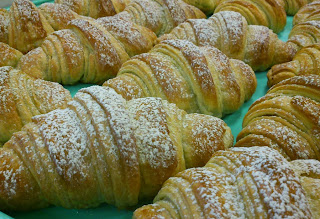Winter break! Finally!
During this last week, the excitement for winter break was definitely palpable. On Monday, we all came into class with the hope that Chef would give us Thursday off. Chef waffled. He doesn't have the authority to give us a day off, but by Tuesday, he gave in saying that as long as we finished everything and cleaned up the classroom by Wednesday, he'd cover for us. :D
Monday entailed more enrobing. This time the filling was piped onto disks of chocolate before being dipped. My partner and I made a peach butter ganache filling - buttery and rich with a smooth peachy flavour running through it. The key to properly piping them was to start 1/2" above the disk and don't move! Just apply constant pressure so the filling would form a fat base and come to a point at the top.
We also dipped some round chocolates and then rolled them on a metal screen to give them a spiky appearance.
Tuesday was practical day. Remember the chocolate box from last week? Well this time it was for real, plus 14 salted caramel chocolates on top. I didn't get any pictures during the process because I was trying to be fast and efficient. We will be remaking these for our capstone at the end of the year and Chef recommended getting the box done in 2-3 hours.
Overall the box went fairly well. No broken petals this time! I did struggle with the individual chocolates. I found that while pouring the final layer of chocolate onto the moulds, it would often push the filling out making holes where the caramel could escape after they were unmoulded! Frustrating. It was only during my evaluation that Chef revealed a better approach to finishing the chocolates. Thaaaanks. :P
So with the curriculum in this class done, what did we have left to do? A showpiece of course! We use up the leftover chocolate that has been colored or tempered and make something nice with it. However, by Wednesday, most of my classmates, myself included, were just not in the mood.
 |
| A paint sprayer we used to spray chocolate onto our base board. |
 |
| Gluing on the reindeer's legs |
The class was divided into two groups, each deciding their own variation on the theme. The theme was a sled with at least 2 reindeer. I was just so tired of school by Wednesday that I really didn't contribute to the final piece, as sad and terrible as that is. I covered the supporting base board with white chocolate, pieced together some presents, and helped move things around. But other than that, I stayed back. The one time I did try to contribute, my team mates got a little snippy. (We had a few controlling members on our team so there was some passive-aggressive tension going on.)
Nevertheless, our class turned out some nice looking pieces. I was very impressed by the sculpting abilities of the other group. Of course, the Santa on ours is just as impressive, but he's hidden by the reindeer and sub-par sled.
 |
| Awesome Santa - all hand sculpted! |
 |
| The other group's sled. Very cute! |
We all needed a break and we finally get one! Come January, I'll be ready to tackle the rest of this year and push through. Merry Christmas and have a wonderful New Years! :D




















































